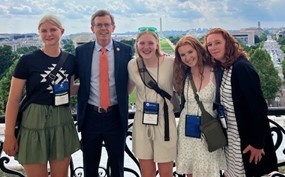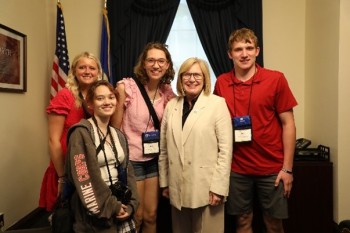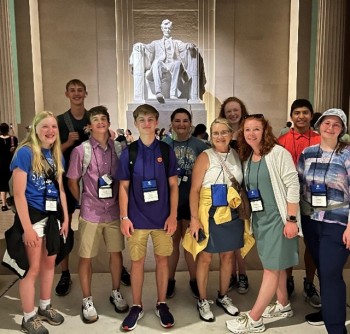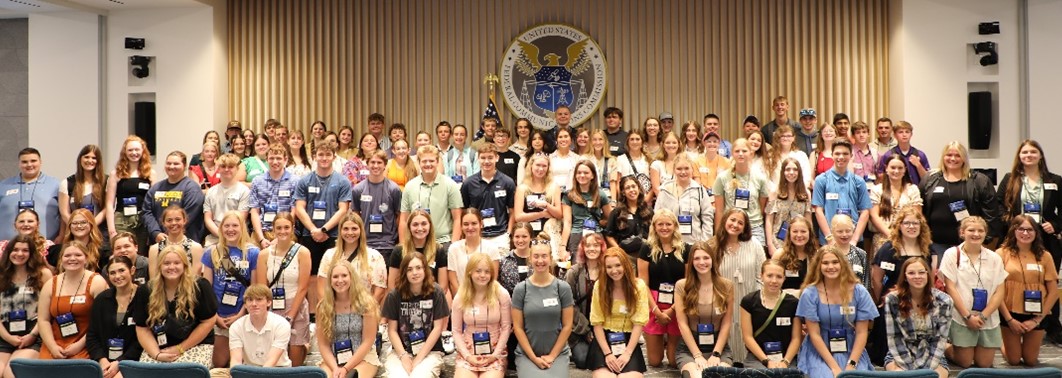Two weeks ago, we waved goodbye to the 130 high school students and chaperones who had been in Washington, D.C., to participate in the 2024 FRS Youth Tour. This flagship program brings students and chaperones from across the country – and as far away as Alaska! -- to Washington, D.C., for five days. It is such an honor to partner with NTCA members and offer this opportunity for their customers to visit our nation’s capital. I am especially proud of the students who bravely got on a plane, even if they had never flown before or traveled without their parents.
We pack the days with exciting stops and educational opportunities. On the first day, we went to Capitol Hill. After a group photo and tour of the U.S. Capitol, we convened in the House of Representatives’ Cannon Caucus Room to learn more about the legislative and regulatory processes from colleagues in the NTCA Government Affairs Department. Then, in a first for Youth Tour, each student and chaperone visited the office of their own member of Congress. Most groups were able to sit down with their U.S. Representative and many even had special opportunities for a photo on the Capitol steps or the chance to watch their representative vote on the House floor. That evening ended with dinner and a performance of Shear Madness at the Kennedy Center for the Performing Arts. Watching this live mystery play was made possible by the generous donors to the Tim Owens Memorial Fund.
The second full day started at the FCC, where we heard from Commissioners Brendan Carr and Anna Gomez, as well as leaders of the new FCC Space Bureau and the E-Rate and 988 programs. The welcome we received at the FCC was wonderful because they love having so many engaged young people interested in their programs. After learning about the future of telecommunications we took a step back in history and toured Mount Vernon, George and Martha Washington’s home on the Potomac River, before some bowling and then a walking tour to see the White House, Washington Monument, Lincoln Memorial, and World War II, Vietnam War and Korean War Memorials.
The final full day was all about the Smithsonian Museums and the variety they offer. For example, some students checked out the iconic Air and Space Museum while others enjoyed the Natural History or American History Museums. There truly is something for everyone! Before heading back to the hotel, we visited Arlington National Cemetery for a private tour that included a stop to see the changing of the guard at the Tomb of the Unknown Soldier. Youth Tour ended with the final dinner where we thanked our brave chaperones and a dance where our DJ played student requests and the dancing was non-stop.
While the interesting sights and educational visits make Youth Tour a wonderful experience, my favorite part of Youth Tour is watching the transformation of the students. Many of the students arrive in Washington, D.C., scared and overwhelmed, but by the end of the Tour they have blossomed into social, excited and curious young people with new friendships they pledge to maintain. These are the people who deeply understand how important rural broadband is for the growth of their rural community. These are the kids who rely on NTCA–The Rural Broadband Association members to further their education by making online classes possible and staying connected to the rest of the world for social, medical and business needs. These kids get it and their visits to Washington, D.C., helped them better understand how public policy can affect their lives every day.
The FRS staff certainly don’t make the Youth Tour magic happen alone. Thank you to those NTCA members who made it possible for students and chaperones in their community to attend the Youth Tour. Thanks to the 28 chaperones who helped guide the students along the way; we truly could not have done it without their help! Thanks also to the generous donors to the Tim Owens Memorial Fund who made our trip to the Kennedy Center possible.
Youth Tour was exhausting, but it always renews my hope and confidence in the next generation and how much they care about rural communities.





